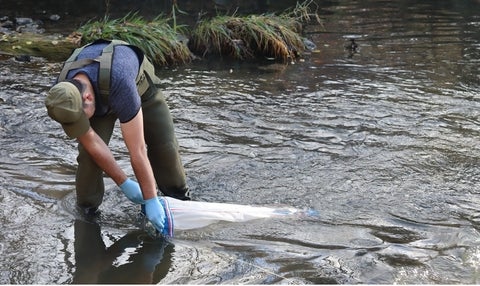
Microplastic sampling in Toronto’s Don River
By: Konrad Krogstad and Stephanie Slowinski
Last fall, members of our research team sampled the Don River to compare microplastics sampling methods. Described as the most urban river in Canada by Canadian Geographic, the Don River passes through Toronto, flowing through a mix of urban residential, commercial, and industrial areas before it empties into Lake Ontario. This makes it a great place to sample because urban areas are major sources of microplastics.
We know from the literature that microplastics tend to make their way into rivers at a higher rate when it rains or snowmelt occurs, as opposed to dry conditions. So when we heard weather forecasters predicting significant rainfall on November 11th, we knew this was a great opportunity for our team to do some sampling.
But before we went out into the field, our team had to first decide which sampling methods we wanted to compare and contrast. There are pros and cons to each type of method and we wanted to better understand the inherent differences between them. For instance, nets are a common choice but only work to capture microplastics above a certain size. Grabbing a sample using a bottle or bucket would give us plastics of all sizes, but the relatively small sample volume risks errors in the concentration calculations.
In the end, we decided to test four different methods: automated water sampler, a continuous flow centrifuge, a plankton net, and grab samples collected using glass jars. We kept track of where and when we took samples, and collected samples using each method at three distinct points: 1) during baseflow (before the river level rose); 2) as the the river level rose; and 3) while the water level fell. This approach will give us the data needed to characterize the changes in microplastics concentrations as river levels (and flows) change during a precipitation event. Another potential source of microplastic pollution in rivers comes from the air, so we also took atmospheric deposition samples throughout the field trip.
So what did we learn? Once we’ve processed the samples, these conclusions will help us figure out which sampling methods work best for different situations. It will lead us towards a more standardized approach that will reduce risks of contamination when collecting samples. This information can be used by conservation authorities and other organizations, in addition to researchers, to select the most effective sampling methods.
Currently, our team in the lab is hard at work analyzing the samples. The results will provide us with initial estimates on the amount of microplastics that urban streams, such as the Don River, transport to lakes. These numbers will feed into our models that will shed light on the sources, sinks, and pathways for plastic litter at the watershed scale. Additonally, the results from this trip will give us with a better understanding of microplastic sampling methods and we will share these findings to benefit the microplastic research community at large.
Photo: Amir Reshadi uses plankton net to sample the Don River